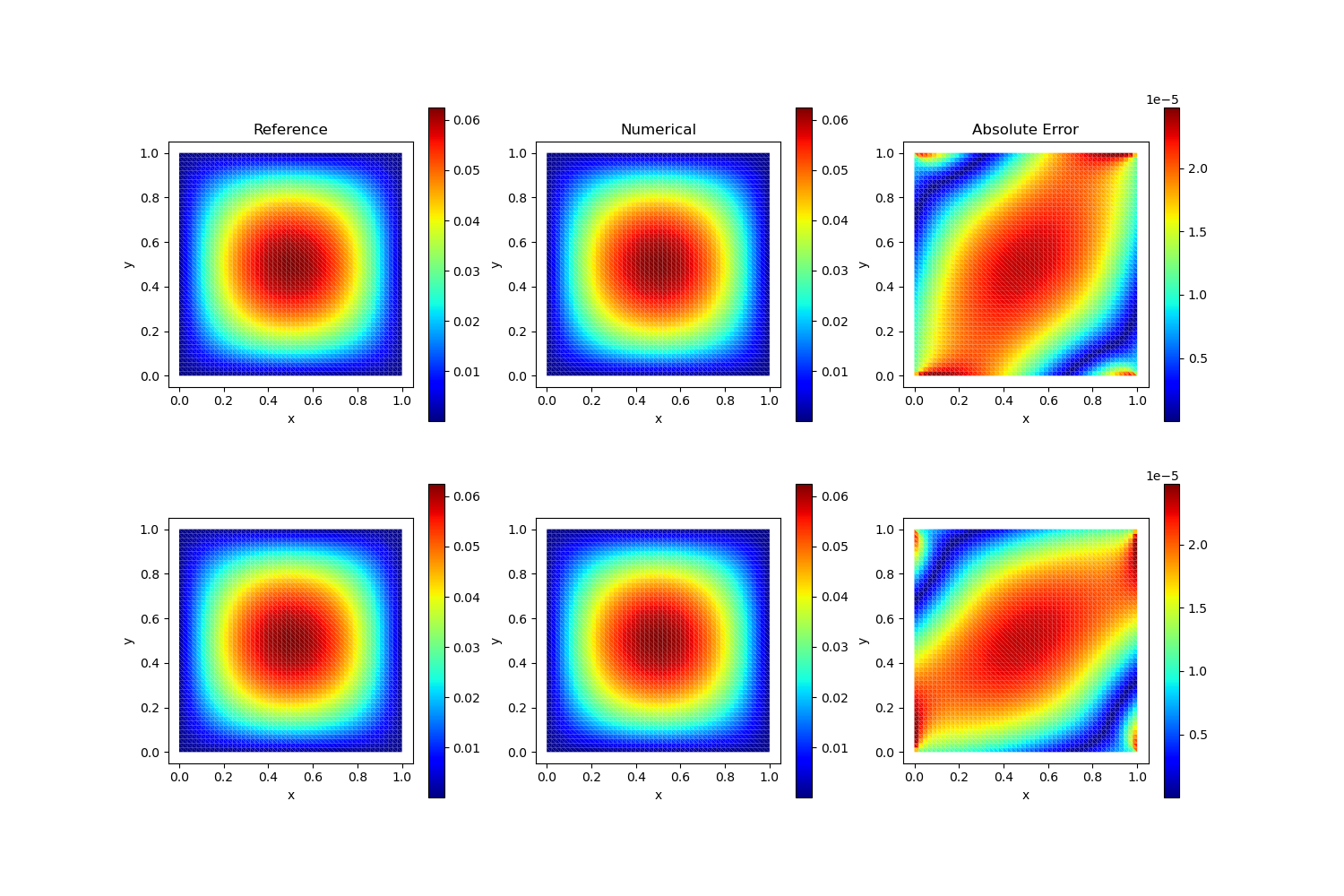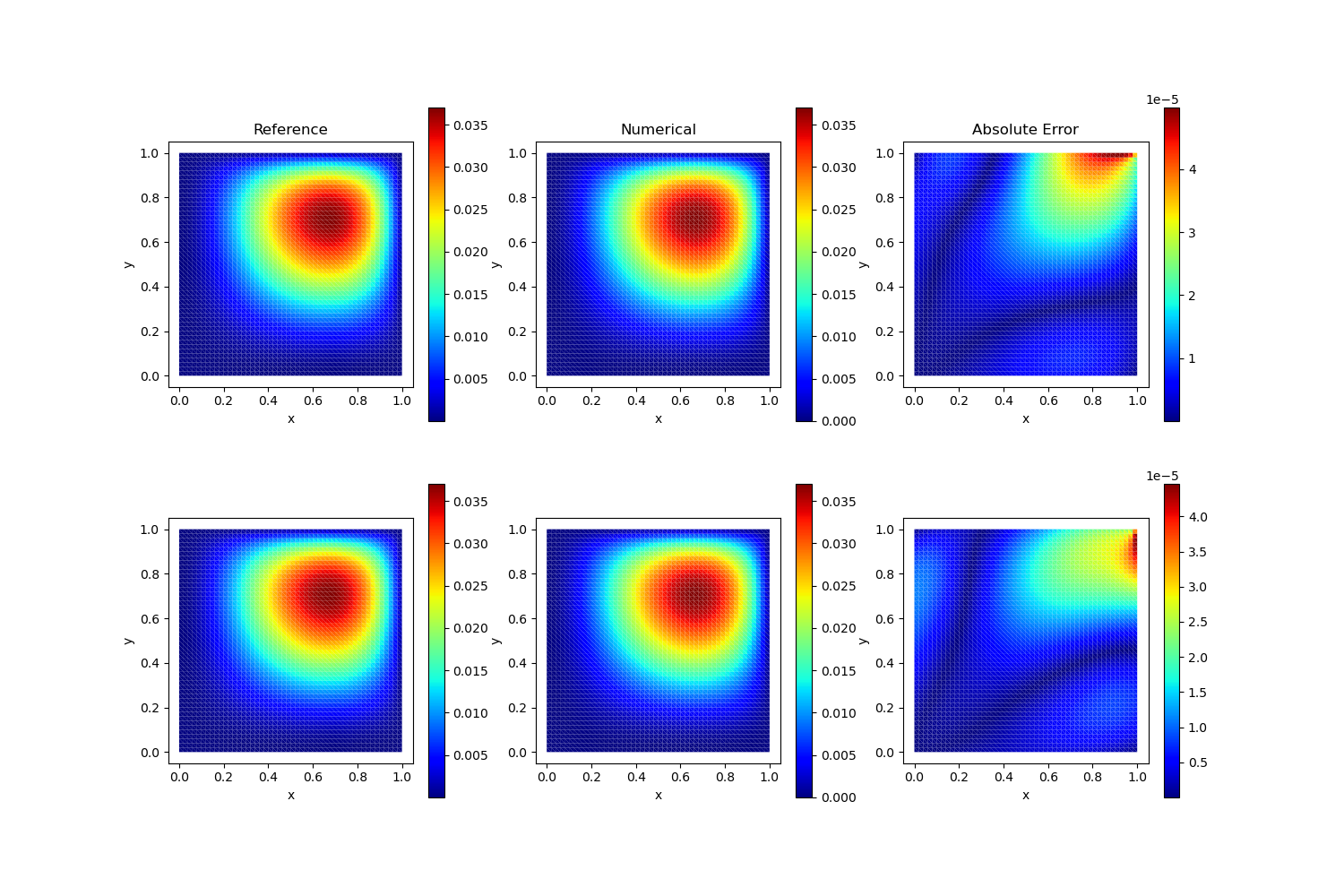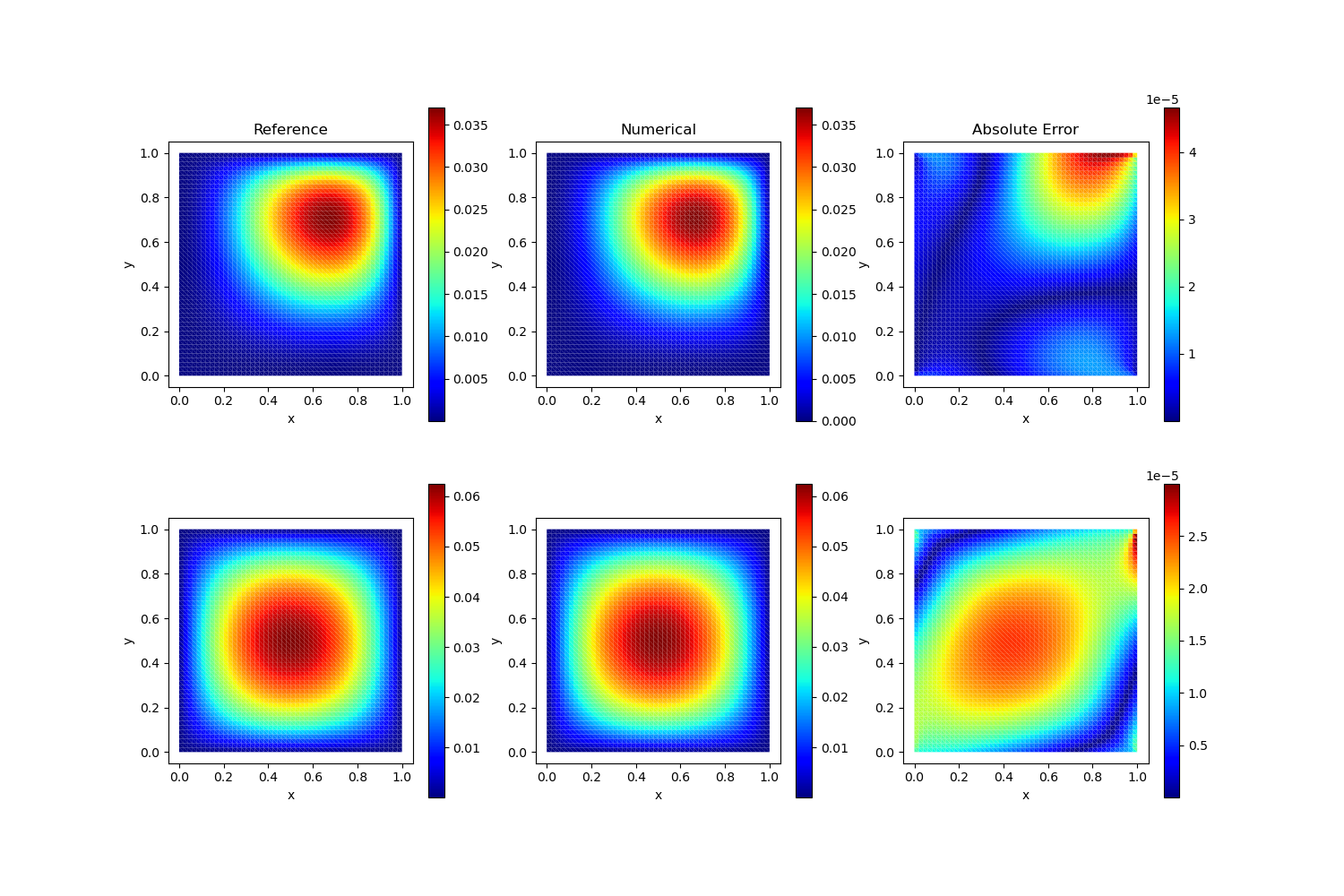Mixed Finite Element Methods for Linear Elasticity
The equations of linear elasticity can be written as a system of equations of the form
\[A\sigma = \varepsilon(u), \quad \text{div} \sigma = f, \text{ in } \Omega\tag{1}\]
Here the unknowns $\sigma$ and $u$ denote the stress and displacement fields, and $f$ is the body force. The stress takes values in the space $\mathbb{S}\in \mathbb{R}^{2\times 2}_{\text{sym}}$ of symmetric matrices. The compliance tensor $A: \mathbb{S}\rightarrow \mathbb{S}$ is a bounded and symmetric, uniformly positive definite operator reflecting the properties of the body.
This section considers a very simple isotropic case where
\[A\sigma = \frac{1}{2\mu}\left(\sigma - \frac{\lambda}{2\mu + 3\lambda}\text{tr}\,\sigma I\right)\]
and we use the weak formulation of Eq. 1
Find $(\sigma, v, \rho)\in H(\text{div}, \Omega; M) \times L^2(\Omega; V) \times L^2(\Omega; K)$, such that for all $(\tau, w, \eta)\in H(\text{div}, \Omega; M) \times L^2(\Omega; V) \times L^2(\Omega; K)$
\[\begin{aligned}(A\sigma, \tau) &+ (\text{div}\,\tau, u) &+ (\tau, \rho) &= (\tau\mathbf{n}, u)_{\partial \Omega} \\ (\text{div}\,\sigma, w) &&=(f, w)\\ (\sigma, \eta) && = 0\end{aligned}\]
Here we have used a skew symmetric trial function $\rho$ and test function $\eta$ as a Lagrange multiplier to relax the symmetry condition on $\sigma$.
The code is as follows:
# Solves the Poisson equation using the Mixed finite element method
using Revise
using AdFem
using DelimitedFiles
using SparseArrays
using PyPlot
λ = 1.0
μ = 1.0
n = 50
mmesh = Mesh(n, n, 1/n, degree = BDM1)
a = 1/2μ
b = -λ/(2μ*(2μ+2λ))
TestCase = [
(
(x,y)->begin;x*y*(x - 1)*(y - 1);end,
(x,y)->begin;x*y*(x - 1)*(y - 1);end,
(x,y)->begin;2.0*x^2 + 8.0*x*y - 6.0*x + 6.0*y^2 - 10.0*y + 2.0;end,
(x,y)->begin;6.0*x^2 + 8.0*x*y - 10.0*x + 2.0*y^2 - 6.0*y + 2.0;end,
),
(
(x,y)->begin;x^2*y^2*(x - 1)*(y^2 - 1);end,
(x,y)->begin;x^2*y^2*(x - 1)*(y^2 - 1);end,
(x,y)->begin;12.0*x^3*y^2 - 2.0*x^3 + 24.0*x^2*y^3 - 12.0*x^2*y^2 - 12.0*x^2*y + 2.0*x^2 + 18.0*x*y^4 - 16.0*x*y^3 - 18.0*x*y^2 + 8.0*x*y - 6.0*y^4 + 6.0*y^2;end,
(x,y)->begin;36.0*x^3*y^2 - 6.0*x^3 + 24.0*x^2*y^3 - 36.0*x^2*y^2 - 12.0*x^2*y + 6.0*x^2 + 6.0*x*y^4 - 16.0*x*y^3 - 6.0*x*y^2 + 8.0*x*y - 2.0*y^4 + 2.0*y^2;end,
),
(
(x,y)->begin;x^2*y^2*(x - 1)*(y^2 - 1);end,
(x,y)->begin;x*y*(x - 1)*(y - 1);end,
(x,y)->begin;12.0*x^3*y^2 - 2.0*x^3 - 12.0*x^2*y^2 + 2.0*x^2 + 18.0*x*y^4 - 18.0*x*y^2 + 8.0*x*y - 4.0*x - 6.0*y^4 + 6.0*y^2 - 4.0*y + 2.0;end,
(x,y)->begin;24.0*x^2*y^3 - 12.0*x^2*y + 6.0*x^2 - 16.0*x*y^3 + 8.0*x*y - 6.0*x + 2.0*y^2 - 2.0*y;end,
)
]
for k = 1:length(TestCase)
@info "Running TestCase $k..."
ufunc, vfunc, gfunc, hfunc = TestCase[k]
A = compute_fem_bdm_mass_matrix(a*ones(get_ngauss(mmesh)), b*ones(get_ngauss(mmesh)), mmesh)
B = compute_fem_bdm_div_matrix(mmesh)
C = compute_fem_bdm_skew_matrix(mmesh)
D = [A B' C'
B spzeros(2mmesh.nelem, 3mmesh.nelem)
C spzeros(mmesh.nelem, 3mmesh.nelem)]
gD = bcedge(mmesh)
t1 = eval_f_on_gauss_pts(gfunc, mmesh)
t2 = eval_f_on_gauss_pts(hfunc, mmesh)
f1 = compute_fvm_source_term(t1, mmesh)
f2 = compute_fvm_source_term(t2, mmesh)
rhs = [zeros(2mmesh.ndof); f1; f2; zeros(mmesh.nelem)]
sol = D\rhs
u = sol[2mmesh.ndof+1:2mmesh.ndof+2mmesh.nelem]
close("all")
figure(figsize=(15, 10))
subplot(231)
title("Reference")
xy = fvm_nodes(mmesh)
x, y = xy[:,1], xy[:,2]
uf = ufunc.(x, y)
visualize_scalar_on_fvm_points(uf, mmesh)
subplot(232)
title("Numerical")
visualize_scalar_on_fvm_points(u[1:mmesh.nelem], mmesh)
subplot(233)
title("Absolute Error")
visualize_scalar_on_fvm_points( abs.(u[1:mmesh.nelem] - uf) , mmesh)
subplot(234)
xy = fvm_nodes(mmesh)
x, y = xy[:,1], xy[:,2]
uf = vfunc.(x, y)
visualize_scalar_on_fvm_points(uf, mmesh)
subplot(235)
visualize_scalar_on_fvm_points(u[mmesh.nelem+1:end], mmesh)
subplot(236)
visualize_scalar_on_fvm_points( abs.(u[mmesh.nelem+1:end] - uf) , mmesh)
savefig("varying_elasticity$k.png")
endWe have 3 test cases and the results are shown below:
Test Case 1
Analytical Solution:
\[u(x,y) = xy(x-1)(y-1) \quad v(x,y) = xy(x-1)(y-1)\]

Test Case 2
Analytical Solution:
\[u(x,y) = x^2y^2(x-1)(y^2-1) \quad v(x,y) = x^2y^2(x-1)(y^2-1)\]

Test Case 3
Analytical Solution:
\[u(x,y) = x^2y^2(x-1)(y^2-1) \quad v(x,y) = xy(x-1)(y-1)\]
